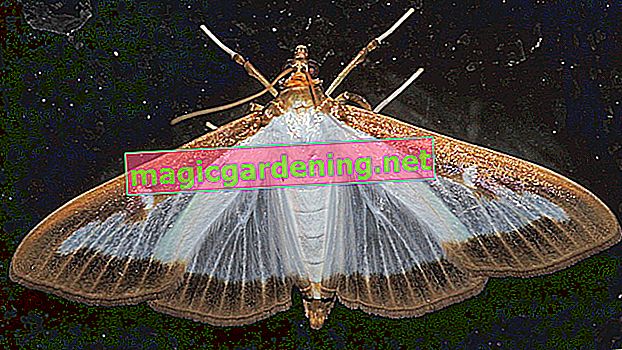
the essentials in brief
- Cat droppings are dark to light brown and have a subtle foul odor. It differs from marten droppings in its small abnormalities.
- In order to prevent cats from excreting in the garden, it should be made unattractive for the four-legged friends. Some plants give off intense aromas that will put cats off.
- Cats can transmit toxoplasmosis or worms through their feces. Dogs eat the leftovers for different reasons.
- According to case law, hobby gardeners must tolerate cat excrement.
What does cat poop look like?

Cats do their business every 24 to 36 hours. They look for a substrate in which they can bury the remains. Therefore, you can often find cat poop in the sandpit. The droppings are deep brown or caramel-like in color and have a firm consistency that is not too hard or soft. The remains are elongated and pliable. They give off a light and not too putrid smell of feces. If the images deviate from the healthy cat excrement, this evaluation system will help further to investigate the cause:
also read
- What you should know about the beech buds
- The birch is a shallow root - what you should know
- Drying borage: you should know that!
| Health problem | Feces | abnormalities | |
|---|---|---|---|
| constipation | extremely hard and dry | Using the toilet is difficult and noticeably rare | |
| diarrhea | pulpy to thin to watery | if ill, apathetic behavior or fever | |
| wrong diet | soft, often light brown or shiny | Intense smell, smelly | |
| Inflammation of the pancreas | light and greasy | frequent use of the toilet | |
| Tarry stool | black | Extremely strong smell |
Marten droppings or cat droppings?
Typically, cats bury their droppings while martens leave their toilet exposed. In contrast to martens, cats are pure carnivores, so that there are no undigested remains of nuts or berries in their feces. Martens use a toilet place more often, so that old and fresh traces of excrement can be found in one place. If you are unsure which culprit did his business in the flower bed, compare pictures from the Internet. These characteristics are typical of marten droppings:
- sausage-shaped and about an inch thick
- slightly twisted in a spiral
- pointed at the ends
- eight to ten inches long
- often mixed with fur and feather remains or seeds
- very unpleasant smell

What to do against cat poop in the garden?
If you want to tackle cat poop in the garden, you need to learn about the house tigers' preferences. They love places that are warm and dry. A soft and sandy surface is ideal for your business and so the pets in beds and sandboxes or in the lawn cause nasty surprises.
YoutubeEffective remedy for cat feces in the garden
With simple tricks you can make your garden cat-safe without injuring the house tiger and thus attracting the ire of the cat owner. Design the environment in such a way that it is as unattractive as possible for the four-legged friend and that they cannot find any access:
- Insurmountable access barrier : plant two meter high trees such as hawthorn and barberry
- Deterrent aromas : sprinkle pepper or chili powder on the bed and lawn
- unwanted shower : place a circular sprinkler on the lawn and equip it with a motion detector
- Unattractive subsoil : Spread plant fleece, pebbles or bark mulch in the bed
If you want to drive away cats with water, you should not spray the animal directly. All you need to do is point a long range water gun in the direction of the cat. Many house cats run away when they get slightly wet. However, the method does not work for all cats.
Preventing cat poop in the garden - natural measures
Many hobby gardeners have had good experiences with dense planting. If the four-legged friends cannot find any vacancies to dig, they keep looking. Leave dead perennials to stand for the winter. The dried up plant stems act as a natural repellent because cats avoid substrates with stinging objects.
Deterrent plants

Cats have a very fine sense of smell that is better developed than humans. You can smell numerous smells that are hidden from the human nose. Conversely, pleasant smells for us are too intense for the cat's nose and act as a deterrent. A cat's sense of smell develops over the course of its life. Cats are less unsettled by unpleasant smells if they are familiar with these aromas from a young age.
These plants are considered to be cat repellent:
- Herbs : curry plant (Helichrysum italicum), lemon grass (Cymbopogon citratus)
- Scented herbs : Lavender (Lavandula angustifolia), peppermint (Mentha × piperita)
- Ornamental herbs : rue (Ruta graveolens), Balkan cranesbill (Geranium macrorrhizum)
background
That's what a cat smells like
Cats orientate themselves primarily visually, but their sense of smell plays a central role in daily life. Their number of olfactory cells is three times higher than the number of sensory cells in the human nose. Cats have 60 million of these tiny olfactory bulbs.A newly born kitten orients itself exclusively with its nose in the first few weeks in order to find its way to the teat. It only opens its eyes in the third week of life. The sense of smell also plays an important role in later life, as communicating through fragrances like pheromones is an important option for conveying messages.
Fuck off plant (Plectranthus ornatus)
In 2001 the plant received special attention because the Swabian breeder Dieter Stegmeier discovered its deterrent effect. When rubbed, the leaves give off a special smell that is reminiscent of menthol. Cats, rabbits, martens and dogs perceive the aroma before they are rubbed and stay away from the plant so that they go to other places for their scent marks and legacies.
How to put the plant:
- at least two plants per square meter
- A low shrub hedge is ideal
- optimal aroma development in sunny and dry locations
What are the dangers of cat poop?
Diseases can result from cat feces. Viruses, bacteria or parasites are often transmitted by smear infection. You should therefore keep an eye out if you discover any abnormalities in the remains or if you find feces extremely smelly. Blood in the cat feces indicates a disease of the upper digestive tract, but does not represent an infectious danger. It becomes more dangerous if you find worms in the cat feces.
The worst thing that can happen in cat poop is worms. Toxoplasmosis, however, is a serious disease for pregnant women.
Toxoplasmosis - danger during pregnancy

Toxoplasmosis is an infectious disease that is common in cats. The pathogen is a parasite that uses the cat as the main host. Affected animals rarely experience symptoms such as diarrhea. People often become infected with toxoplasmosis when they consume insufficiently heated pork. Therefore, vegetarians are less likely to be infected with the disease. In healthy people, the disease usually has no symptoms. The following symptoms can rarely occur:
- light fever
- Swelling of the lymph nodes in the neck
- fatigue
- Pain in the head and limbs
Infected people do not need treatment. Once the disease has healed, the organism forms antibodies and prevents re-infection. If women first become infected during pregnancy, the newborn is at risk. It can lead to miscarriages or damage to the unborn child.
Help, my baby ate cat poop
If your cat is healthy and regularly dewormed, there is no danger for the little explorers. You can become infected with parasites if they put cat feces in their mouths while playing in the sandpit. So don't panic and examine the cat's feces for possible abnormalities such as worms.
Tips
Spread apple cider vinegar in the bed or stick garlic cloves in the ground. Cats don't like either of these at all, so avoid your garden as a toilet space.
Cat scratch disease - cat poop makes you blind?
This disease is caused by the bacterium Bartonella henselae, which can be found in up to 70 percent of cats. It gets into the human organism through scratches and can also be transmitted through cuddles. Cat fleas and their feces are another source of infection. It is not known that the disease is transmitted through cat feces. Usually the disease is benign and shows itself as swollen lymph nodes. Red-brown papules on the contact wound that disappear spontaneously after a few days are typical.
Symptoms in immunocompromised people:
- rarely skin diseases
- cysts in the liver filled with blood
- Inflammation of the meninges or the lining of the heart
- Inflammation of the optic nerve with subsequent blindness
Why do dogs eat cat poop?
Eating feces is known in specialist circles as coprophagia. Some dogs will eat the leftovers out of the litter box if it is not cleaned directly. This behavior is not only disgusting but also dangerous for humans and animals. Parasites, viruses and bacteria can be transmitted to the dog and stick to the snout, paws or in the fur. In this way they get into the human organism the next time they are cuddled.
Possible reasons for eating feces:
- Lack of hygiene in the dog kennel
- Stress from strict parenting
- Frustration from frequent loneliness
- habitual behavior to get attention
- Parasitic infestation or disease of the pancreas
In many animals, eating feces is a sign of nutrient deficiency. It could not be confirmed in practice that the dogs suffer from an insufficient supply of nutrients. In principle, coprophagia should be prevented directly if you observe this behavior in your dog. If the habit persists for a long period of time, take the situation seriously and investigate the exact cause.
Cat droppings in the case law
Homeowners are subject to an obligation of mutual consideration in neighborly relations. This also means that the property owner must tolerate visits from neighbors' cats. In most cases, a ban on keeping cats is illegal. If the exercise of cats in a residential area is classified as common, there are no legal measures against the animal left behind in the garden.
Tips
If you line your flower beds with rose clippings, the area will become unattractive for cats. They avoid the thorny ground because they could injure their soft paws.
frequently asked Questions
How can I remove cat poop from the carpet?

Remove the residue from the carpet as soon as possible with a plastic bag before it dries up. Lay out absorbent wipes so that any traces of urine are soaked up. Clean the area with a lukewarm soapy solution until all residue has been removed. Mineral water is an old household tip that is suitable for treating stains and for wool carpets. You can use baking soda to remove the odor.
For some time now I've been observing a particularly stubborn tomcat who keeps doing his business in my garden. What helps against cat poop in the garden?
Such culprits can be deterred with a cocktail of intensely fragrant substances. Use an empty margarine beaker and pour boiling water over a black tea bag. Let the tea steep for a few minutes and add a few drops of eucalyptus or peppermint essential oil. A few splashes of Tabasco round off the intense scented cocktail.
Close the cup with the plastic lid and poke a few holes through it with a nail. Dig the jar up to the lid in a strategic location so that it is secure and protected. The cocktail will exude its scent over the bed in the coming days.
I have tried every measure to keep cats out of my garden. Nothing worked. What to do?
Make a virtue out of necessity and set up a special place for the cat for its aftermath. They prefer to do their business in dry and sunny places where the substrate is loose. Dig a hollow one square meter and ten to eight inches deep and fill the hole with sand. To avoid having to see the litter box every day, you can use certain plants as a border:
- Catnip (Nepeta x faassenii)
- Amur ray pen (Actinidia kolomikta)
- Germander (Teucrium)
- Real valerian (Valeriana officinalis)
The four-legged friends are attracted by the scents of these plants and thus distracted from your beds. If the sand is heavily polluted, you can bury it in the garden. With this variant, you don't expect any nasty surprises when you care for the bed and you always know where the cat poop is.
How can I dispose of litter with cat droppings?
You can flush cat feces down the toilet if there is no large residue of the litter on it. However, you should not empty the entire litter box in the toilet, otherwise the pipes could clog. Litter made of plant fibers or paper, on the other hand, can also be used in the sewage system, because these substrates do not clump together in the pipes. There are special bags and trash cans for cat droppings in which you can temporarily store the leftovers. Cat droppings are not recommended as fertilizer.








